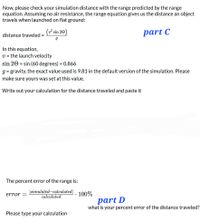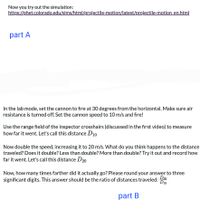
College Physics
11th Edition
ISBN: 9781305952300
Author: Raymond A. Serway, Chris Vuille
Publisher: Cengage Learning
expand_more
expand_more
format_list_bulleted
Concept explainers
Topic Video
Question
thumb_up100%
The class I'm taking is physics for scientists and engineers!
****Need help with parts C and D****
I am completely stuck. Need help. I have attached the problem. Please view both attachments before answering. I have also attached the link to the simulator. I have solved part A and b. I need help with part C and D please. Any help will be greatly appreciated! Thank you!

Transcribed Image Text:Now, please check your simulation distance with the range predicted by the range
equation. Assuming no air resistance, the range equation gives us the distance an object
travels when launched on flat ground:
(v² sin 20
)
part C
distance traveled =
In this equation,
V = the launch velocity
sin 20 = sin (60 degrees) = 0.866
g = gravity, the exact value used is 9.81 in the default version of the simulation. Please
%3D
make sure yours was set at this value.
Write out your calculation for the distance traveled and paste it
The percent error of the range is:
|simulated-calculated|
error =
100%
calculated
part D
what is your percent error of the distance traveled?
Please type your calculation

Transcribed Image Text:Now you try out the simulation:
https://phet.colorado.edu/sims/html/projectile-motion/latest/projectile-motion en.html
part A
In the lab mode, set the cannon to fire at 30 degrees from the horizontal. Make sure air
resistance is turned off. Set the cannon speed to 10 m/s and fire!
Use the range field of the inspector crosshairs (discussed in the first video) to measure
how far it went. Let's call this distance D10
Now double the speed, increasing it to 20 m/s. What do you think happens to the distance
traveled? Does it double? Less than double? More than double? Try it out and record how
far it went. Let's call this distance D20
Now, how many times farther did it actually go? Please round your answer to three
D20
significant digits. This answer should be the ratio of distances traveled:
D10
part B
Expert Solution
This question has been solved!
Explore an expertly crafted, step-by-step solution for a thorough understanding of key concepts.
This is a popular solution
Trending nowThis is a popular solution!
Step by stepSolved in 2 steps

Knowledge Booster
Learn more about
Need a deep-dive on the concept behind this application? Look no further. Learn more about this topic, physics and related others by exploring similar questions and additional content below.Similar questions
- Part A A cannon tilted up at a 29.0 ° angle fires a cannon ball at 68.0 m/s from atop a 10.0 m -high fortress wall. What is the ball's impact speed on the ground below? ΑΣφ ? Vf = m/s Submit Previous Answers Request Answerarrow_forwardJae throws a 0,350kg ball so that it is traveling at 7.50m/s toward a wall, approaching the wall at an angle of 35.0⁰ as shown in the figure to the right. After hitting the wall, the speed of the ball is still 7.50m/s but its direction has changed and it is now traveling at an angle of 35.0° away from the wall as shown to the right. a) Sketch on your paper a figure like the one shown to the right and show the vectors for the momentum before impact, PB, the momentum after impact, PA, and use them to find Ap, the change in momentum for the ball. Clearly label each vector. b) Calculate the sign and magnitude of Apx, the change in momentum in the x direction. c) Calculate the sign and magnitude of Apy the change in momentum in the y direction. d) If the collision lasts for 0.150 seconds, find the magnitude of the average force on the ball during the collision. What is the direction of the average force on the ball during the collision? Answer this by showing an arrow and label it as Fave-…arrow_forwardHelp! An asteroid is heading towards us at 10 km/s. Scientists decide the best solution is to attach a rocket to the asteroid and fire it to change the trajectory of the asteroid. If the rocket is fired for 8 min, the scientists calculate that the new speed for the asteroid will be 21 km/s and its new trajectory will be at an angle of 25° to its original path. Part A In the process described above, what is the acceleration of the asteroid? Express your answers using two significant figures separated by a comma. Assume that the positive axis is in the direction of the initial motion of the asteroid. The final motion of the asteroid has components in the x and positive y directions only. ax ay = for Part A for Part A undo for Part A redo for Part A reset for Part A keyboard shortcuts for Part A help for Part A Review I Constants m/s2arrow_forward
- Still i am confused with your answer. Please explain each and every option so that i can understand the solution. (Please if you are not sure ,Kindly don't attempt this question I will rate as unhelpful if you give the wrong answer)arrow_forwardQuestion on image (this is a practice problem not real test questions)arrow_forwardPls help ASAP. Pls show all work, steps and calculations please.arrow_forward
arrow_back_ios
arrow_forward_ios
Recommended textbooks for you
 College PhysicsPhysicsISBN:9781305952300Author:Raymond A. Serway, Chris VuillePublisher:Cengage Learning
College PhysicsPhysicsISBN:9781305952300Author:Raymond A. Serway, Chris VuillePublisher:Cengage Learning University Physics (14th Edition)PhysicsISBN:9780133969290Author:Hugh D. Young, Roger A. FreedmanPublisher:PEARSON
University Physics (14th Edition)PhysicsISBN:9780133969290Author:Hugh D. Young, Roger A. FreedmanPublisher:PEARSON Introduction To Quantum MechanicsPhysicsISBN:9781107189638Author:Griffiths, David J., Schroeter, Darrell F.Publisher:Cambridge University Press
Introduction To Quantum MechanicsPhysicsISBN:9781107189638Author:Griffiths, David J., Schroeter, Darrell F.Publisher:Cambridge University Press Physics for Scientists and EngineersPhysicsISBN:9781337553278Author:Raymond A. Serway, John W. JewettPublisher:Cengage Learning
Physics for Scientists and EngineersPhysicsISBN:9781337553278Author:Raymond A. Serway, John W. JewettPublisher:Cengage Learning Lecture- Tutorials for Introductory AstronomyPhysicsISBN:9780321820464Author:Edward E. Prather, Tim P. Slater, Jeff P. Adams, Gina BrissendenPublisher:Addison-Wesley
Lecture- Tutorials for Introductory AstronomyPhysicsISBN:9780321820464Author:Edward E. Prather, Tim P. Slater, Jeff P. Adams, Gina BrissendenPublisher:Addison-Wesley College Physics: A Strategic Approach (4th Editio...PhysicsISBN:9780134609034Author:Randall D. Knight (Professor Emeritus), Brian Jones, Stuart FieldPublisher:PEARSON
College Physics: A Strategic Approach (4th Editio...PhysicsISBN:9780134609034Author:Randall D. Knight (Professor Emeritus), Brian Jones, Stuart FieldPublisher:PEARSON

College Physics
Physics
ISBN:9781305952300
Author:Raymond A. Serway, Chris Vuille
Publisher:Cengage Learning

University Physics (14th Edition)
Physics
ISBN:9780133969290
Author:Hugh D. Young, Roger A. Freedman
Publisher:PEARSON

Introduction To Quantum Mechanics
Physics
ISBN:9781107189638
Author:Griffiths, David J., Schroeter, Darrell F.
Publisher:Cambridge University Press

Physics for Scientists and Engineers
Physics
ISBN:9781337553278
Author:Raymond A. Serway, John W. Jewett
Publisher:Cengage Learning

Lecture- Tutorials for Introductory Astronomy
Physics
ISBN:9780321820464
Author:Edward E. Prather, Tim P. Slater, Jeff P. Adams, Gina Brissenden
Publisher:Addison-Wesley

College Physics: A Strategic Approach (4th Editio...
Physics
ISBN:9780134609034
Author:Randall D. Knight (Professor Emeritus), Brian Jones, Stuart Field
Publisher:PEARSON